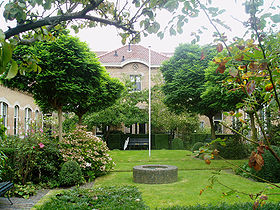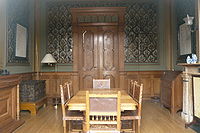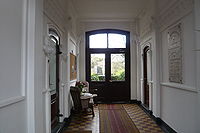
Zuiderhofje
Encyclopedia




Hofje
A hofje is a Dutch word for a courtyard with almshouses around it. They have existed since the Middle Ages.A hofje provided housing for elderly people . They were privately funded, and served as a form of social security...
in Haarlem
Haarlem
Haarlem is a municipality and a city in the Netherlands. It is the capital of the province of North Holland, the northern half of Holland, which at one time was the most powerful of the seven provinces of the Dutch Republic...
, Netherlands
Netherlands
The Netherlands is a constituent country of the Kingdom of the Netherlands, located mainly in North-West Europe and with several islands in the Caribbean. Mainland Netherlands borders the North Sea to the north and west, Belgium to the south, and Germany to the east, and shares maritime borders...
.
History
The hofje was founded in 1640 by Jacques van Damme and his wife Elisabeth Blinckvliedt, and is owned by the MennoniteMennonite
The Mennonites are a group of Christian Anabaptist denominations named after the Frisian Menno Simons , who, through his writings, articulated and thereby formalized the teachings of earlier Swiss founders...
church of Haarlem. The couple gave an order to Michael Slaghreegen on the 25th of February 1640, to purchase a house on the Zuiderstraat and build a few houses there for elderly women of the Vlaemsche Block, the largest branch of Mennonites in Haarlem at that time. This branch was primarily Flemish
Flemish people
The Flemings or Flemish are the Dutch-speaking inhabitants of Belgium, where they are mostly found in the northern region of Flanders. They are one of two principal cultural-linguistic groups in Belgium, the other being the French-speaking Walloons...
in origin, and their church De Olijblock was located on the Klein Heiligland street, near their orphanage
Orphanage
An orphanage is a residential institution devoted to the care of orphans – children whose parents are deceased or otherwise unable or unwilling to care for them...
, Het Doopsgezinde Weeshuis. The orphanage archives date back to 1634, and its location adjoined the former hofje Blokshofje, that can still be seen, but was sold by the Mennonite church in 1970. A commemorative plaque on the front explains the history of that house.
Mennonites of Haarlem
This hofje is one of four Mennonite hofjes in Haarlem; the others are the WijnbergshofjeWijnbergshofje
The Wijnbergshofje is a hofje in Haarlem, Netherlands, on the Barrevoetstraat.It was founded in 1662 by the Mennonite Church. It was renovated in 1872 and contains 9 houses for pensioners...
in the Barrevoetestraat, the Bruiningshofje
Bruiningshofje
The Bruiningshofje is a hofje in Haarlem, Netherlands.-History:It was founded in 1610 by Jan Bruininck Gerritz , and is one of four hofjes owned by the Mennonite church of Haarlem. The others are the Wijnbergshofje in the Barrevoetestraat, the Zuiderhofje on the Zuiderstraat, and the Blokshofje on...
on the Botermarkt, and the Blokshofje on the Klein Heiligland sold in 1970. This is not counting the Teylers Hofje
Teylers Hofje
The Teylershofje is a hofje in Haarlem, Netherlands with 24 houses.-History of the foundation:The current hofje was built in 1787 from the legacy of Pieter Teyler van der Hulst, just like the Teylers Museum close to it. Pieter Teyler van der Hulst originally founded a hofje when his wife died in...
, though its founder was Mennonite and its former location had also been a Mennonite hofje. Considering the fact that the Mennonite community was never more than 5% of the Haarlem population, it is unusual that they have always been in the majority among the regents of Haarlem hofjes. The reason is that the Mennonites in Haarlem ran a quarter of all charity work for centuries in Haarlem, until government control slowly took over in the 20th century. The Haarlem archives mention the followers of Zwingli as far back as 1530. The Frisian
Frisians
The Frisians are a Germanic ethnic group native to the coastal parts of the Netherlands and Germany. They are concentrated in the Dutch provinces of Friesland and Groningen and, in Germany, East Frisia and North Frisia, that was a part of Denmark until 1864. They inhabit an area known as Frisia...
preacher Menno Simons
Menno Simons
Menno Simons was an Anabaptist religious leader from the Friesland region of the Low Countries. Simons was a contemporary of the Protestant Reformers and his followers became known as Mennonites...
was not the founder of this faith, but a later leader. This is why the Dutch Mennonites don't call themselves Mennonites, but Doopsgezind, or Baptist
Baptist
Baptists comprise a group of Christian denominations and churches that subscribe to a doctrine that baptism should be performed only for professing believers , and that it must be done by immersion...
. Each Doopsgezind group is autonomous. The main rules of the faith in 1640 were:
- Refusal to baptise children until the age of 18
- Refusal to take vows or swear oaths
- Refusal to carry arms
Many Haarlem Mennonites were Flemish immigrants from Menen
Menen
Menen is a municipality located in the Belgian province of West Flanders. The municipality comprises the city of Menen proper and the towns of Lauwe and Rekkem. The city is situated on the French/Belgian border. On January 1, 2006, Menen had a total population of 32,413...
, in Belgium
Belgium
Belgium , officially the Kingdom of Belgium, is a federal state in Western Europe. It is a founding member of the European Union and hosts the EU's headquarters, and those of several other major international organisations such as NATO.Belgium is also a member of, or affiliated to, many...
, who came for the linen trade, but there was also a large group who came from Friesland
Friesland
Friesland is a province in the north of the Netherlands and part of the ancient region of Frisia.Until the end of 1996, the province bore Friesland as its official name. In 1997 this Dutch name lost its official status to the Frisian Fryslân...
, and friction between these groups was common. Since most men of influence in Haarlem at that time were members of the schutterij
Schutterij
Schutterij refers to a voluntary city guard or citizen militia in the medieval and early modern Netherlands, intended to protect the town or city from attack and act in case of revolt or fire. Their training grounds were often on open spaces within the city, near the city walls, but, when the...
, the only way for influential men of the Mennonite community to advance themselves socially was through social work and cultural donations.
Officially, the Mennonite faith was only tolerated, and not recognized by the Haarlem city council. The Mennonite churches were underground, but its members could move freely in society, just as the Catholics could do after the Protestant Reformation
Protestant Reformation
The Protestant Reformation was a 16th-century split within Western Christianity initiated by Martin Luther, John Calvin and other early Protestants. The efforts of the self-described "reformers", who objected to the doctrines, rituals and ecclesiastical structure of the Roman Catholic Church, led...
of 1572. The only difference was that they had to pay wachtgeld to avoid the schutterij militia service. The Flemish Mennonites were the strictest followers of their faith. In 1598 a scandal over a bankruptcy caused a schism in the Haarlem Mennonite church, and in 1620 a controversy arose over the question whether a man could fondle his betrothed's breast before marriage. This question split the church, so that at the time of the Hofje's founding, there were 5 Mennonite groups in Haarlem. All of these communities were known for their shunning
Shunning
Shunning can be the act of social rejection, or mental rejection. Social rejection is when a person or group deliberately avoids association with, and habitually keeps away from an individual or group. This can be a formal decision by a group, or a less formal group action which will spread to all...
of members who broke the rules.
Elisabeth Blinkvliedt
After her husband's death in 1642, Elisabeth Blinkvliedt decided to write up a codicil to their bequest of the hofje. Knowing her church well, she stipulated that the hofje regents could act as they saw fit, without any influence of the Mennonite church except that the regents should be members of it. The appointing of regents was only to be done by the current sitting regents, and the business of the hofje was to have no communion with the business of the Mennonite church. She then appointed the sitting group of regents, and these were- Michael Slaghreegen
- Pieter Joosten Bogaert (he was also the founder of the original hofje in the now Vrouwe- en Antonie GasthuysVrouwe- en Antonie GasthuysThe Vrouwe- en Antonie Gasthuis is a hofje in Haarlem, Netherlands.-Foundation:This hofje is run by a foundation called 'Vrouwe- en Antonie Gasthuis', which was founded in 1440 as a guest house for pilgrims seeking shelter...
hofje) - Dirk de Wale
- J. de Graeff
She then added a new house and garden to the complex in 1644, and as though this wasn't enough, she also added a new house and garden to the Bruiningshofje
Bruiningshofje
The Bruiningshofje is a hofje in Haarlem, Netherlands.-History:It was founded in 1610 by Jan Bruininck Gerritz , and is one of four hofjes owned by the Mennonite church of Haarlem. The others are the Wijnbergshofje in the Barrevoetestraat, the Zuiderhofje on the Zuiderstraat, and the Blokshofje on...
in 1647. In the archives of the Bruiningshofje a sum of 150 Carolus guldens is recorded for this purpose, received from Lysbeth van Blenckvliet.
In 1649 she wrote a Memorie, or memoir, in which she asks the regents of this hofje to do a few more things for her after her death. Thanks to this paper we know that she and her husband were the founders of the above-mentioned orphanage in the 1630s, and in her memoir she echoes her stipulation for the hofje that the orphanage should be completely self-supporting, with no interference by the Mennonite church. Her gifts on her death were quite substantial, and are the reason that the hofje was to last for so many centuries, despite later upheavals in the Haarlem Mennonite community.
Effects of schisms in the church
In 1672 the Haarlem Mennonite community was split in two and the Zuiderhofje had to give up a third of its wealth to the Gemeente van Vollenhove. In 1683 the Vlaemsche Block, now merged with the Waterlandsche Gemeente, moved to a new church building in the Frankestraat, where the Haarlem Mennonite community still resides today. In 1685 the hofje was appointed new regents from this united church, which was directly against the wishes of Elisabeth Blinckvliedt. In 1714 this was declared illegal, but in 1716 a final decision was made to allow the church to appoint the regents, and the hofje was declared the property of the church. In 1749 the Mennonite communities rejoined and the old property rights were restored, except that the church kept its (illegal) governance. In 1782 the regents wrote a letter to the church to complain. The church protested that it had made donations to the hofje since 1685. Finally, in 1784, a decision was made to allow the various Mennonite hofjes to exist independently of each other, and independently of the church. The hofjes mentioned were the Winbergshofje and the Zuiderhofje.Restoration activities
After a glorious period in the 18th and early 19th centuries, thanks to rich donations by regents, the hofje slowly declined. In 1887 the first discussions about restoration began and in 1891 the hofje was completely torn down and rebuilt. In 1892 the elderly women returned to their new homes after a year of living elsewhere. The hofje, together with the Hofje van Gratie, was threatened with destruction in the 1960s when the library was built (located in the old stadsdoelen, or target practise for the city schutterijSchutterij
Schutterij refers to a voluntary city guard or citizen militia in the medieval and early modern Netherlands, intended to protect the town or city from attack and act in case of revolt or fire. Their training grounds were often on open spaces within the city, near the city walls, but, when the...
). In the end only the Hofje van Gratie was torn down. This hofje now stands as an island among newer buildings.
The hofje is for single, senior women.
Address: Zuiderstraat

